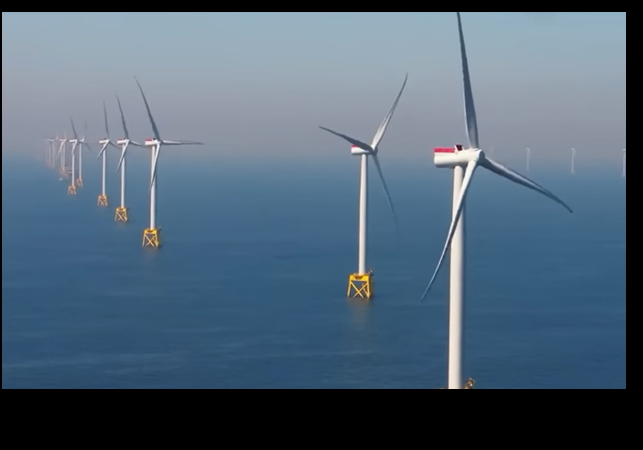A couple of weeks ago, Sweden’s government ditched plans to go all-in on “green energy,” green-lighting the construction of new nuclear power plants. Shortly afterward, fossil fuel giant Shell announced it was scaling back its energy transition plans to focus on . . . gas and oil!
Now it looks like specific wind farm projects are beginning to topple due to strong economic headwinds. Recent, Rhode Island’s leading utility decided to nix a project called Revolution Wind 2 because the cost of the electricity was deemed too high.
“Higher interest rates, increased costs of capital and supply chain expenses, as well as the uncertainty of federal tax credits, all likely contributed to higher proposed contract costs,” said the utility, Rhode Island Energy, in a press release. “Those costs were ultimately deemed too expensive for customers to bear and did not align with existing offshore wind power purchase agreements.”
Those same cost factors are wreaking havoc in Massachusetts. Two major offshore wind developers in Massachusetts are terminating their power purchase agreements with the state’s utilities because the developers say the agreements, hammered by inflation, interest rate hikes, supply chain disruptions, and the war in Ukraine, are no longer sufficient to secure financing for their projects.
The developers hope to rebid the contracts in the state’s next procurement in 2024, presumably at much higher prices. The decision by Rhode Island Energy could foreshadow the pricing Massachusetts might see next year.
In Europe, Swedish energy firm Vattenfall will stop the development of a major wind project in the United Kingdom after a surge in costs (Hat-tip Hot Air’s Beege Welborne). Once again, the issue was related to surges in energy costs.
The project won a contract-for-difference (CfD) in an auction last year, guaranteeing a minimum price of 37.35 pounds per megawatt hour (MWh) in 2012 prices for the electricity produced, which equates to around 45 pounds/MWh today.
Since the auction, called round 4, some developers have warned that soaring project costs, inflation and interest rates have meant the price guarantee offered then could leave the projects uneconomic and called for targeted help for the sector.
Vattenfall also said it would examine the best way forward for the entire Norfolk zone which also includes the Vanguard East and West projects.
Combined, the three projects were expected to produce some 4.2 GW of electricity.
The economic headwinds associated with wind farms are beginning to be noticed.
…. Even as the White House is welcoming it with open arms and the Democrats’ climate law is channeling money in its direction, strong economic headwinds are blowing in the opposite direction – inflation and rising interest rates have hit the industry hard.
And then there’s the whales: Some citizen groups and conservative media have blamed a rise in whale strandings and deaths this year on the nascent wind farm projects – a connection scientists have so far found no evidence for.
The combination has made it a precarious time for offshore wind, said Jason Grumet, CEO of the American Clean Power Association, the trade group representing US clean energy.
“This is the vulnerable moment where the benefits are on the horizon,” Grumet told reporters this spring. “Because we don’t have the benefits of it on the table. We don’t have massive facilities producing energy, lowering prices in those states.”
I would like to note that determining whether the “science” indicates whales are dying due to wind farm construction is complicated. No serious cetologist would be likely to come to any certain conclusion based on the evidence obtained from all the marine mammals that have washed up on the shores of New Jersey and New York in the past few months.
However, scientific evidence and a serious review of the numbers shows that the power and reliability of wind pales in comparison to one traditional energy source.
The EIA [US Energy Information Administration] website is very illuminating with regard to the energy produced by wind and coal power at Mount Storm and the question “can wind power can replace coal power?”. In the 12-month period (May 2020-April 2021) the coal power plant operated at approximately 32% of its rated capacity. The 181 wind turbines operated at just over 21% of rated capacity. The coal plant generated 5,752GWh of electricity, and the wind turbines 932GWh. It would require an additional 936 similar sized wind turbines to replace the electricity generated by the coal plant during the same 12-month period.
Peak power production for the coal power plant was in July 2020 (719GWh) which was also the month for the lowest output for wind (34.6GWh). In July, the wind turbines produced just 4.8% of the power produced by the coal power plant while operating at only 9.4% of rated capacity. In the month of July, it would require at least 3,764 similar sized wind turbines to replace the electricity generated by the coal power plant which was operating at just 47% of rated capacity.
I suspect that the winds of energy policy will blow in a different direction as people realize that green energy fantasies are different from the cold, hard realities.

